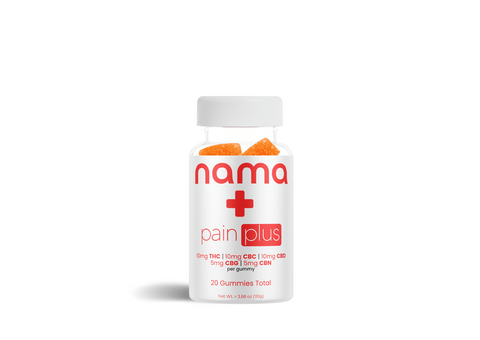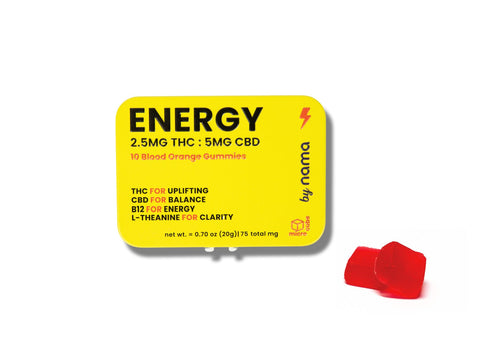
Cervical cancer remains a significant global health issue, despite advancements in screening and treatment options. Recent studies have explored the anticancer effects of cannabis and found that microdoses of THC and CBD may induce cell death and inhibit cell growth in many cancer types, including cervical cancer.
A 2016 study showed that cannabis sativa extracts and cannabidiol reduced cell viability in cervical cancer cell lines. Contassot, et. al. found that certain endocannabinoids induce apoptosis in cervical carcinoma cells by interacting with the endocannabinoid system (ECS).
There are many reasons why you should microdose cannabis and ditch other harmful methods of consumption. Explore the benefits of microdosing through our low-dose THC edibles.
If you are battling cervical cancer and want to try low-dose cannabis, our all-natural THC edibles give you a safe, convenient, and delicious way to do so. Ditch smoking and vaping and discover the benefits of microdosing cannabis with gummies.


THC: 10 mg | CBC: 10 mg | CBD: 10 mg | CBG: 5 mg | CBN 5mg
Understanding cervical cancer
Cervical cancer originates in the cervix, which is the lower part of the uterus that connects to the vagina. It is primarily caused by the human papillomavirus (HPV), a sexually transmitted infection.
When precancerous changes in the cervical cells, known as cervical intraepithelial neoplasia (CIN), are not detected and treated promptly, they have the potential to progress to invasive cervical cancer. This process usually takes several years, but in some cases, it can develop more rapidly. As the cancerous cells grow and divide, they can invade the surrounding tissues and spread to other parts of the body (metastasis).
How do you know you have cervical cancer?
Cervical cancer in its early stages may not cause noticeable symptoms. Symptoms of cervical cancer may include:
- Abnormal vaginal bleeding: this may occur between menstrual periods, after sexual intercourse, or after menopause.
- Unusual vaginal discharge: a watery, pink, or foul-smelling discharge that may contain blood.
- Pain or discomfort in the pelvic area, particularly during sexual intercourse.
- Discomfort or a burning sensation while urinating.
- Irregular menstrual bleeding that is heavier or lasts longer than usual, or bleeding after menopause.
- Swelling of the legs: in advanced stages, cervical cancer may cause swelling in one or both legs due to obstruction of lymphatic drainage.
- Unexplained weight loss.
- Back pain.
- Decreased appetite.
If you experience any of these symptoms, especially if they persist or worsen over time, consult a healthcare provider for a proper evaluation and diagnosis.
The risk factors of cervical cancer
Here's an explanation of the risk factors that contribute to the development of cervical cancer:
- The majority of cervical cancer cases are caused by persistent infection with high-risk types of HPV, particularly types 16 and 18. HPV is transmitted through sexual contact, and most sexually active individuals will be exposed to the virus at some point in their lives. In some cases, the HPV virus integrates its genetic material into the host cell's DNA. This integration disrupts the normal functioning of the host cell's tumor suppressor genes, which normally regulate cell growth and division.
- Women who become sexually active at a young age have a higher risk of developing cervical cancer. In younger women, the cervical cells are still developing and are more susceptible to HPV infection.
- Women who smoke have a higher risk of developing cervical cancer than non-smokers. Smoking weakens the immune system, making it harder for the body to fight off HPV infections.
- Women with weakened immune systems, such as those with HIV/AIDS or those taking immunosuppressive medications, have a higher risk of developing cervical cancer. A weakened immune system makes it harder for the body to clear HPV infections.
- Some studies suggest that long-term use of oral contraceptives (birth control pills) for more than five years may slightly increase the risk of cervical cancer. This risk seems to decrease after stopping the use of oral contraceptives.
- Women who have had a past or current chlamydia infection have a higher risk of developing cervical cancer.
- Women from low-income backgrounds may have limited access to healthcare services, including regular cervical cancer screening, which can lead to a delay in the detection and treatment of precancerous changes.
- A family history of cervical cancer, particularly in a first-degree relative (mother, sister, or daughter), may increase a woman's risk of developing the disease.
One or more of these risk factors does not necessarily mean that a woman will develop cervical cancer. Regular cervical cancer screening and HPV vaccination can reduce the risk of developing the disease, even in the presence of these risk factors.
How is cervical cancer treated?
The treatment of cervical cancer depends on the stage, the size of the tumor, and the patient's overall health. The goal of treatment is to eliminate the cancerous cells while minimizing damage to healthy tissue.
Treatment options for cervical cancer include:
- In early-stage cervical cancer, surgery may be used to remove the cancerous tissue. This can include a cone biopsy (removal of a cone-shaped piece of cervical tissue), a hysterectomy (removal of the uterus), or a trachelectomy (removal of the cervix) for women who wish to preserve their fertility.
- Radiation therapy uses high-energy beams to destroy cancer cells.
- Chemotherapy uses drugs to kill cancer cells throughout the body. It may be used alone or in combination with radiation therapy, especially for advanced-stage cervical cancer.
- Targeted therapy targets specific proteins or pathways that contribute to cancer growth.
- Immunotherapy harnesses the power of the patient's immune system to fight cancer cells.
- For women with advanced cervical cancer, palliative care focuses on managing symptoms, relieving pain, and improving quality of life.
In many cases, a combination of these treatment modalities may be recommended for the best possible outcome. These aggressive approaches often come with a host of unpleasant side effects that can impact a patient's quality of life.
Microdosing cannabis has emerged as a promising adjunct therapy that may help alleviate the harsh adverse effects of traditional treatments, while also contributing to the fight against cancer through its potent anticancer effects.
How does cannabis fight cancer?
Research has shown that cannabis has potent anti-tumor properties in preclinical models. A comprehensive review by Hinz and Ramer (2022) explains how cannabis compounds such as Delta 9 THC and cannabidiol (CBD) combat cancerous tumor growth and fight many types of gynecologic cancers including cervical cancer.
The review found that:
- THC and CBD can inhibit the growth and spread of cancer cells by targeting signaling pathways involved in cell proliferation. By suppressing these pathways, cannabinoids can induce cell cycle arrest and prevent cancer cells from multiplying and spreading to healthy tissues.
- Cannabis compounds may trigger programmed cell death (apoptosis) in cancer cells. They increase the production of reactive oxygen species (ROS), activating caspases, and modulating the expression of pro-apoptotic and anti-apoptotic proteins, which helps to reduce tumor growth and slows its progression.
- Cannabinoids can inhibit the formation of new blood vessels (angiogenesis) that supply nutrients and oxygen to tumor cells. This limits their growth and ability to spread.
- Certain cannabis compounds can interact with the immune system to enhance the body's natural defense against cancer. For instance, CBD may increase the susceptibility of cancer cells to the cytotoxic effects of immune cells, while THC reduces the infiltration of immunosuppressive cells into the tumor microenvironment.
Preet, et. al. also found that “THC was able to inhibit tumor growth and lung metastases in a murine model of lung cancer.” Honarmand, et. al. suggested that “treatment with CBD reduced colon cancer cell proliferation, induced apoptosis, and also had anti-metastatic and anti-angiogenesis effects.”
This shows that cannabis may help fight lung cancer, colon cancer, and many other types of carcinomas. Let’s look at the evidence for cervical cancer.
Can cannabis help treat cervical cancer?
A comprehensive study review published in 2021 revealed that cannabis and the endocannabinoid system play an important role in female reproductive events and pathologies, including many types of gynecological cancers.
The review found that:
- Anandamide, an endocannabinoid compound, induces cell death in cervical cancer cell lines like HeLa and Caski, likely by activating the TRPV1 receptor.
- CBD has been shown to decrease invasiveness and cell proliferation in cervical cancer cell lines by upregulating TIMP-1, an inhibitor of matrix metalloproteinases involved in metastasis.
While more research is still needed, this review highlighted the potent anti-tumor effects of CBD, THC, and other minor cannabinoids and terpenes that act through the body’s endocannabinoid system to suppress the development and progression of cervical cancer.
The ECS is a crucial regulatory system in the human body that is composed of naturally produced cannabinoid-like molecules, the receptors they bind to, and enzymes that synthesize and break them down. The plant-derived cannabinoids from the cannabis plant interact with and modulate this system, mimicking the effects of natural cannabinoids your body produces.
South African researchers confirm that cannabis can induce apoptosis and inhibit invasion, migration, and angiogenesis in cervical cancer cells through modulation of the endocannabinoid system and different signaling pathways.
Hinz and Ramer continue to reveal important information about the anti-cervical cancer properties of cannabis, suggesting that the “induction of tissue inhibitor of metalloproteinase-1 (TIMP-1) expression was shown to be a cause of the anti-invasive effect of THC, Met-AEA and CBD in cervical and lung cancer cells.” In simple terms, THC, CBD, and anandamide showed an anti-invasive effect against cervical and lung cancer cells by inducing the expression of an enzyme inhibitor that blocks the spread of cancer.
A 2008 study found that several common chemotherapy drugs used to treat cervical cancer work in part by increasing levels of the enzyme COX-2 in cancer cells. COX-2 catalyzes the production of prostaglandins, which are signaling molecules involved in inflammation and cell proliferation. Higher COX-2 leads to the production of certain prostaglandins, causing the cancer cells to undergo apoptosis.
Before making any definitive claims about microdosing cannabis as a viable treatment for cervical cancer, more clinical studies are needed. That said, our low-THC and balanced CBD gummies can provide relief from cancer symptoms and treatment side effects without causing significant intoxication.
If you’re looking for a mildly euphoric experience coupled with effective anti-inflammatory and analgesic benefits, give our Bliss Delta 9 gummies a try. Only 5 milligrams of THC and CBD in each delicious gummy is a perfect amount for anyone struggling with cancer pain or harsh chemo-induced adverse effects.
"These gummies are the best. They are an absolute staple. They’ve replaced my happy hour glasses of wine. I’ve shared my love for these gummies with friends and they’ve all purchased them, too!"
Product QUIZ
Need help deciding what product is best for you? Take our quiz, just three questions until your perfect match!
Low-dose cannabis for chemotherapy-related side effects
Cannabis has long been used to mitigate the adverse side effects associated with chemotherapy. Through the endocannabinoid system, THC and CBD alleviate common and debilitating side effects chemotherapy patients often experience.
Fehniger, et. al. suggested that many women with gynecologic cancers find relief from cancer- and treatment-related side effects with medicinal cannabis, mainly for nausea and pain relief. Cannabis can be beneficial for cervical cancer patients undergoing chemotherapy by helping alleviate nausea, pain, and other side effects such as:
- The stress and anxiety from a cancer diagnosis and treatment can take a toll on mental health. By interacting with serotonin receptors in the brain, cannabis can help manage anxiety and depression symptoms, promoting relaxation and improving mood for better overall mental well-being.
- Insomnia and poor sleep quality plague many cancer patients including women with cervical cancer diagnosis. Low doses of medical cannabis can aid sleep by promoting relaxation and reducing anxiety.
- Nausea and vomiting are among the most difficult side effects of chemo. Low doses of cannabis can induce antiemetic effects. THC interacts with CB1 receptors in the ECS to directly suppress the nausea and vomiting reflex in the brain.
- Cancer pain can be alleviated by the analgesic effects of THC and CBD. THC alters pain perception via CB1 receptors in the ECS, while CBD's anti-inflammatory properties help reduce irritation and pain.
- Loss of appetite is common during chemotherapy. This can lead to dangerous weight loss. As an appetite stimulant, THC can help by triggering the release of the hunger-promoting hormone called ghrelin through CB1 receptors in the brain.
Whether you need relief from chronic pain, help to alleviate harsh side effects from cancer treatment, or simply want to kick back and relax, our low-dose cannabis gummies and THC beverages are the perfect choice.
Order our Relax Plus gummies to experience a new dimension of tranquility in your life. These easy-to-dose edibles provide the perfect balance of Delta 9 and CBD, which work together to induce munchies, promote restful sleep, and lower stress and anxiety.
If you’re looking for a fun and easy way to buzz up your favorite non-alcoholic drink, our low-dose Buzz drops™ are all you need. This innovative tincture contains only 2.5 mg of THC and 2.5 mg of CBD per full dropper, so you can adjust the dose to your liking and tolerance.
Learn how to infuse any beverage with cannabis for a social and relaxing experience.
Is it legal to microdose cannabis?
Delta 9 THC is federally legal in the US under 2018 Farm Bill, which stipulates the following:
- The THC is derived from hemp, not marijuana
- The THC content does not exceed 0.3% by dry weight.
The Farm Bill removed hemp from the list of controlled substances, legally separating hemp from marijuana. This means that all of our THC edibles and CBD gummies are 100% legal at the federal level because they’re made from organic hemp.
Each state chooses independently whether cannabis products containing Delta 9 THC will be legal in that state. For example, you can’t buy our Delta 9 edibles in Idaho and Kansas. Check out our detailed guide to state-by-state THC legality for more information.
If you’re looking to buy the best THC edibles in the country, nama™ is the obvious choice. We care about what goes into our gummies, so we make sure we use only the highest quality ingredients and natural flavors.
Cervical cancer FAQ
The standard treatments for cervical cancer typically involve surgery, radiation therapy, and chemotherapy depending on the stage. For early-stage cervical cancer, surgery such as a hysterectomy or cone biopsy may be the most effective. More advanced stages often require a combination of radiation and chemotherapy. Some studies published by the International Journal of Cancer suggest that medicinal cannabis may have antiproliferative and synergistic effects when combined with conventional treatments, potentially enhancing their efficacy.
Many cervical cancer patients can achieve long-term survival, with 5 and 10-year survival rates depending heavily on the stage at diagnosis. Data from Cancer.net shows 5-year survival over 90% for localized cervical cancer, but the rate drops to around 17% for distant metastatic disease. With early detection and proper treatment, 10-year survival is possible for a good proportion of cervical cancer patients.
When used appropriately, cannabis can be perfectly safe for everyone including cancer patients. Small amounts of THC and CBD can be a safer alternative for managing cancer symptoms and treatment side effects compared to some conventional medications. The secret lies in keeping the THC content low and balancing it with CBD, as high amounts of THC may cause unwanted side effects such as disorientation, increased anxiety or sedation, and memory impairment. These adverse effects can be especially challenging for cancer patients who are already dealing with a lot.
Lower THC doses allow patients to reap the potential benefits without the added stress of intense psychoactive effects. Plus, they may have anti-tumor properties, making them a promising addition to cancer care.
Stage 4 is the most advanced stage when cervical cancer has spread to distant sites such as the lungs, bones, or liver. Survival rates are low, with a 5-year survival of only around 17%. New treatments and cannabis-based therapies that show synergistic effects could potentially improve outcomes in the future, even for late-stage disease.
There are several ways in which you can decrease your chances of developing cervical cancer:
- HPV vaccination to prevent human papillomavirus infection. According to the International Agency for Research on Cancer, HPV is a leading cause of cervical neoplasia in women.
- Regular screening to detect precancerous cervical dysplasia and cervical infections. This is important to do early, before the cancer progresses.
- Cut out tobacco use, which has been identified as a potential independent risk factor.
Some evidence points to the efficacy of cannabis in decreasing the risk of developing certain cancers, such as cervical cancer. Preclinical studies on breast cancer cell lines and mouse models show flavonoids present in cannabis have antiproliferative and cytotoxic effects, inhibiting tumor growth. This anticancer potential involves modulating pathways that regulate cancer cell survival, invasion, and metastasis. Some research also hints at synergistic effects when combining cannabis compounds with chemo or radiation to sensitize stubborn cancer cells.
While promising, rigorous clinical trials are still needed to validate the anticancer efficacy and safety of medical marijuana products before recommendations.
Cancer patients often sleep more than usual because of the physical and emotional toll the disease and its treatments take on their bodies. Fatigue is a common symptom of cancer treatments such as radiation treatment and chemotherapy, which can lead to increased sleep duration during the day and night.
Excessive daytime sleepiness may signify something more concerning such as disease progression, side effects, depression, or other psychosocial factors. Proper sleep hygiene is vital for cancer patients, as oversleeping has been linked to poorer outcomes in some cancer epidemiology studies.
Human papillomavirus (HPV) infection accounts for almost all cervical cancer cases. Only very rarely do cases of cervical adenocarcinoma arise without any HPV involvement. While HPV is the primary risk factor, other potential contributors such as smoking, HIV, genetics, and chemical exposures play smaller roles based on epidemiological studies.
Early-stage cervical cancers that are localized may be treated with surgery, sometimes combined with radiation therapy, without requiring chemotherapy. For more advanced or aggressive cervical cancers that have spread further, chemotherapy is usually needed along with radiation and surgery as part of the overall treatment plan. Emerging research does suggest the potential benefits of combining medicinal cannabis with conventional therapies for a synergistic effect, but more research is required.
Top Sellers
New? Start with our Ultimate Sampler!

THC: 10 mg | CBC: 10 mg | CBD: 10 mg | CBG: 5 mg | CBN 5mg
Resources
Lukhele, S. T., & Motadi, L. R. (2016). Cannabidiol rather than Cannabis sativa extracts inhibit cell growth and induce apoptosis in cervical cancer cells. BMC Complementary and Alternative Medicine, 16(1). https://doi.org/10.1186/s12906-016-1280-0
Contassot E, Tenan M, Schnüriger V, Pelte MF, Dietrich PY. Arachidonyl ethanolamide induces apoptosis of uterine cervix cancer cells via aberrantly expressed vanilloid receptor-1. Gynecol Oncol. 2004 Apr;93(1):182-8. doi: 10.1016/j.ygyno.2003.12.040. PMID: 15047233.
Dyer, O. (2002). WHO links long term pill use to cervical cancer. The BMJ, 324(7341), 808. https://doi.org/10.1136/bmj.324.7341.808/a
Hinz, B., & Ramer, R. (2022). Cannabinoids as anticancer drugs: Current status of preclinical research. British Journal of Cancer, 127(1), 1-13. https://doi.org/10.1038/s41416-022-01727-4
Preet A, Ganju RK, Groopman JE. Delta9-Tetrahydrocannabinol inhibits epithelial growth factor-induced lung cancer cell migration in vitro as well as its growth and metastasis in vivo. Oncogene. 2008 Jan 10;27(3):339-46. doi: 10.1038/sj.onc.1210641. Epub 2007 Jul 9. PMID: 17621270.
Honarmand, M., Namazi, F., Mohammadi, A., & Nazifi, S. (2018, August 27). Can cannabidiol inhibit angiogenesis in colon cancer? Comparative Clinical Pathology. https://doi.org/10.1007/s00580-018-2810-6
Taylor, A. H., Tortolani, D., Ayakannu, T., Konje, J. C., & Maccarrone, M. (2020). (Endo)Cannabinoids and Gynaecological Cancers. Cancers, 13(1). https://doi.org/10.3390/cancers13010037
Razlog, R., Kruger, C. A., & Abrahamse, H. (2022). Enhancement of Conventional and Photodynamic Therapy for Treatment of
Cervical Cancer with Cannabidiol. Integrative Cancer Therapies, 21. https://doi.org/10.1177/15347354221092706
Eichele K, Ramer R, Hinz B. Decisive role of cyclooxygenase-2 and lipocalin-type prostaglandin D synthase in chemotherapeutics-induced apoptosis of human cervical carcinoma cells. Oncogene. 2008 May 8;27(21):3032-44. doi: 10.1038/sj.onc.1210962. Epub 2007 Dec 10. PMID: 18071320.
Fehniger, J., Brodsky, A. L., Kim, A., & Pothuri, B. (2021). Medical marijuana utilization in gynecologic cancer patients. Gynecologic Oncology Reports, 37, 100820. https://doi.org/10.1016/j.gore.2021.100820
Russo, E. B. (2011). Taming THC: Potential cannabis synergy and phytocannabinoid-terpenoid entourage effects. British Journal of Pharmacology, 163(7), 1344-1364. https://doi.org/10.1111/j.1476-5381.2011.01238.x
nama CBD FDA & legal disclaimer
Our products are not intended as medical advice, diagnosis, or treatment of any disease. They are not a replacement for prescription medications and have not been evaluated by the Food and Drug Administration (FDA).
The information provided on this website does not and is not intended to, constitute legal advice or any statements of the status of any laws. Any information, content, and materials available on this site are for general informational purposes only and are not intended to be relied upon for any purpose.
Readers of this website should contact their attorney to obtain advice with respect to any particular legal matter including decisions on what products are, or are not, legal to sell, possess, or consume. No reader, user, or browser of this site should act or refrain from acting on the basis of information on this site without first seeking legal advice from their own counsel in the relevant jurisdiction.
Only your individual attorney can provide assurances that the information contained herein – and your interpretation of it – is applicable or accurate for your particular situation. Use of, and access to, this website or any of the links or resources contained within the site do not create an attorney-client relationship between the reader, user, or browser, and website authors, contributors, contributing law firms, or committee members and their respective employers.
About
Learn
Join us on this journey

© Copyright 2025 nama Products LLC. All Rights Reserved.
†These statements have not been evaluated by the Food and Drug Administration. These products are not intended to diagnose, treat, cure or prevent any disease. All information presented here is not meant as a substitute for or alternative to information from health care practitioners. Please consult your health care professional about potential interactions or other possible complications before using any product.
††The information provided on this website does not, and is not intended to, constitute legal advice or any statements of the status of any laws. Any information, content, and materials available on this site are for general entertainment purposes only, and are not intended to be relied upon for any purpose.

By clicking ‘Yes,’ you agree to our
Terms & Conditions and Privacy Policy
123 John Doe Street
Your Town, YT 12345
Store Hours
Sun: Closed
Mon-Fri: 9:00 - 17:00
Sat: 10:00 - 13:00
What to expect at pickup
Closed
Closing at 5pm
Closing at 5pm
Closing at 5pm
Closing at 5pm
Closing at 5pm
Closing at 1pm



![Euphoria Kiwi Raspberry [10ct]](http://www.namacbd.com/cdn/shop/files/nama_kiwi_raspberry_pouch.png?v=1715285056&width=480)
![Euphoria Kiwi Raspberry [10ct]](http://www.namacbd.com/cdn/shop/files/nama_euphoria_kiwiraspberry_nutrition_facts.jpg?v=1715873960&width=480)
![Euphoria Triple Berry [10ct]](http://www.namacbd.com/cdn/shop/files/nama_euphoria_triple_berry_pouch.png?v=1715286095&width=480)
![Euphoria Triple Berry [10ct]](http://www.namacbd.com/cdn/shop/files/nama_euphoria_tripleberry_nutrition_facts.jpg?v=1715873950&width=480)


![Buzz Drops™ [THC Drink Drops]](http://www.namacbd.com/cdn/shop/files/nama_thc_buzz_drops.png?v=1711412866&width=480)
![Buzz Drops™ [THC Drink Drops]](http://www.namacbd.com/cdn/shop/files/buzz-drop-wine-comparison.png?v=1736882023&width=480)
![Buzz Packs™ [THC and CBD Powder Drink Mix]](http://www.namacbd.com/cdn/shop/files/nama_buzz_packs_thc_drink_pack_white_background.png?v=1741884660&width=480)
![Buzz Packs™ [THC and CBD Powder Drink Mix]](http://www.namacbd.com/cdn/shop/files/Buzz_Packs_Label.png?v=1741884660&width=480)
















Comments (0)
There are no comments for this article. Be the first one to leave a message!